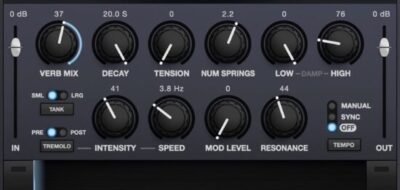That unmistakable boingy, splashy sound of spring reverb is one of the quintessential effects in music production. From early rock n’ roll to surf rock, from spaghetti westerns to psychedelic rock, spring reverb has been adding its lush ambience to recordings for decades.
But as iconic as spring reverb may be, it can also be challenging to work with when mixing. Too much spring reverb can make your tracks sound distant, muddy, and washed out. Not enough, and you lose that classic vibe. The key is learning how to effectively blend spring reverb to enhance your mix rather than overwhelm it.
In this post, we’ll break down the key steps for mixing with spring reverb. You’ll learn pro tips and tricks for balancing spring reverb’s unique character with clarity and definition in your mixes. We’ll look at setting reverb level, tweaking tone, dialing in reverb time, treating the dry and wet signals differently, and more.
With these mixing techniques, you’ll be able to add that vintage spring reverb magic to your tracks without sacrificing punch and articulation.
Whether you’re using actual spring tank units or spring reverb VSTs, these mixing guidelines will help you achieve great-sounding spring reverb that sits perfectly in your mixes.
Setting the Right Spring Reverb Level
One of the most critical things to get right when mixing with spring reverb is the wet/dry balance – how much of the direct, dry sound versus the reverberant, wet signal you blend together. Set the level too high, and the reverb can quickly overwhelm the source, making it sound distant and muddy. Too low, and you won’t get enough of that gorgeous spring reverb vibe.
Start by setting up your spring reverb as a send effect on an aux track rather than as an insert. This allows you to dial in the perfect wet/dry balance for each individual track. The key is to resist the urge to crank the reverb send level too high right away. As a general rule, set it lower than you think you need, around -10 to -15dB to start. Slowly increase the send level as you get a feel for how the reverb complements the direct sound. Stop raising it when the reverb blends nicely without covering up the source.
You can also automate the send level where certain words, notes, or phrases need more or less reverb for creative effect. For example, pulling the send down on a vocal before a big chorus can let the lyric cut through clearly. In general, use more subtle spring reverb on elements that need clarity like vocals, guitars, and snare drum. Drench instruments like organs and background pads more heavily. Get it right, and your spring reverb will add vintage vibe without losing detail and articulation.
EQing for the Best Spring Reverb Tone
Once you’ve set the reverb level, the next crucial step is EQing the spring reverb to get the best tone. The resonant metallic sound of springs can easily get harsh and overwhelming without some EQ tweaking.
Start by rolling off some of the low frequencies. Spring reverb tends to build up muddy boominess down low, so a high pass filter around 80-120 Hz can clean things up. Cutting a bit around 400-600 Hz can also tame resonant peaks that make the reverb sound boxy.
Next, try boosting the high end above 2-3 kHz. This will add air and clarity to the reverb so it doesn’t get too dark and muddy. Add brightness until the reverb has crispness but isn’t harsh. A shelf boost around 8-10 kHz can also restore sheen.
Be careful with midrange EQ – too much boost around 1-2 kHz can make the reverb tinny and metallic sounding. A narrow notch or low Q bell cut around offensive resonant peaks can be useful.
Overall the goal is to shape the spring reverb tone to complement the source track. Matching the EQ profile of the reverb and source signal often sounds most natural. Get it right and your spring reverb will have vintage character without turning the mix to mud.
Dialing in the Right Reverb Time
One of the most distinctive aspects of spring reverb is the decay time. Vintage spring reverbs often have a lush, elongated decay compared to digital reverbs. However, longer decay times can make the reverb overwhelm slower tempos. Here are some tips for choosing the right reverb time when mixing with spring reverb:
- For faster tempos, tighter rhythms, and percussive instruments, use a shorter decay time around 1-2 seconds. This prevents the reverb from bleeding into subsequent notes.
- For slower ballads, sustained pads/strings, and vocals, you can extend the decay time to 2.5-3.5 seconds or longer. The longer decay complements the slower rhythms.
- Set the reverb time in relation to the space between notes, chords, and phrases in the music. The decay should finish before the next musical event.
- Use longer times on reverbs sent to background instruments and shorter times on foreground elements like snare and vocals.
- Automate the reverb time where you want certain words or notes to have a longer decay for effect.
The goal is to find the sweet spot where the decay sustains long enough to be vintage-sounding but not so long that it turns the mix to mush. Let the arrangement and tempo guide your reverb time settings when mixing with spring reverb.
Conclusion
Mixing with spring reverb effectively is a balancing act. You want to harness its lush, vintage character without letting it overwhelm the mix. By starting with a conservative reverb level, EQing it for clarity, setting an appropriate decay time, and processing the dry and wet signals differently, you can achieve that perfect blend.
The key is listening critically to the relationship between the direct sound and reverb. They need to complement each other – the dry sound providing clarity and detail, the reverb providing a complementary ambience. Tweak the amount of reverb, tone, and decay time until you strike the right balance.
Don’t be afraid to also use spring reverb creatively for sound design. From twisted psychedelic effects to spaghetti western gunshots, it can add interest when used dramatically. Just be sure to cut the reverb when needed so it doesn’t bleed everywhere.
With some practice, spring reverb can give your mixes or tracks a retro vibe while still sounding clean and polished. Let your ears guide you to that sweet spot where the reverb brings out the best in the music. Harness the power of springs!









